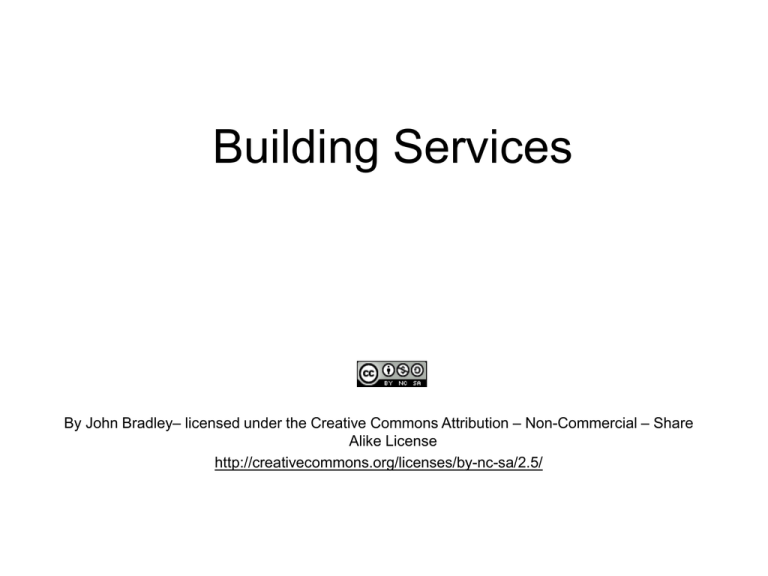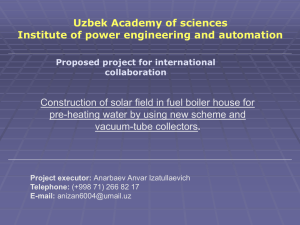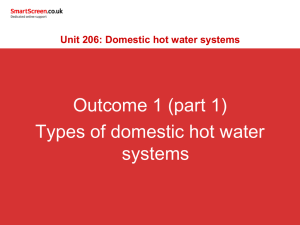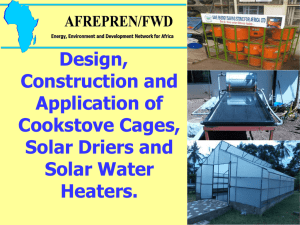Unvented Systems
advertisement

Building Services By John Bradley– licensed under the Creative Commons Attribution – Non-Commercial – Share Alike License http://creativecommons.org/licenses/by-nc-sa/2.5/ John Bradley INTRODUCTION Hot water E C ρ1 ρ2 = = = = Expansion (m3) Volume of water in system (m3) Density of water before heating (kg/m3) Density of water after heating (kg/m3) DHW Systems Instantaneous Multi point Single point Stored Vented Unvented CONVENTIONAL VENTED SYSTEM Cold water storage cistern Overflow pipe Vent pipe (at least 19mm) Boiler Immersion heater to hot water outlets Cylinder Cold feed pipe Coil heat exchanger Cold water supply from rising main Secondary circuit Primary circuit Heating and hot water system CWSC Vent pipe Overflow pipe 80mm Support for CWSC Additional expansion space Normal expansion space Cold feed pipe Rising main Flat, level, rigid platform to extend > 150mm beyond cistern Conventional vented system: direct • • • • An alternative to the indirect system that is not now commonly used, but occurs in many older properties, is a direct system. In direct systems the water in the cylinder is heated directly, either by an electric immersion heater in the cylinder, or by the water being circulated around a boiler. This was a common arrangement with back-boilers behind open fireplaces and ranges such as Agas and Rayburns, but is not generally used with central heating boilers. The hot water from the boiler mixes directly with the water in the cylinder. Water that has circulated in the boiler and primary circuit is drawn off through the taps and can therefore be contaminated. If used in a soft water area the boiler must be rust-proofed. This system is not suited to hard waters. When heated the calcium in the water precipitates to line the boiler and primary pipework, eventually furring up the system making it ineffective and dangerous. Immersion heaters Immersion heater Legionella • • There is an increased risk of bacterial growth in water held at temperatures between 20°C and 46°C for prolonged periods. This can cause Legionnaires’ disease. The elderly are particularly vulnerable. Control of the bacteria is therefore vital in settings such as hospitals and care homes. The following measures are recommended for use with hot water systems: – Stored hot water temperature 60 to 65oC throughout the storage vessel – Pipework ‘dead-legs’ to be minimal – All pipework to be insulated to reduce water temperature losses – Distribution temperature to outlets >55oC Advantages Disadvantages Easy to maintain Poor shower performance because of the relatively low pressure at which water is delivered Low maintenance costs especially with electric heating Possible water contamination (from debris entering the feed and expansion tank) Relatively easy to install Noisy cistern filling as water is drawn off and replenished from the mains supply Less to go wrong when compared with other systems Fixed system design and limited positioning options because of the need to generate a head of pressure Less risk of being without a hot water supply due to breakdown Potential freezing hazard of the feed and expansion tank Gain the traditional airing cupboard Likelihood of unbalanced hot and cold water supplies UNVENTED SYSTEM Unvented Systems • Until the 1985 Building Regulations and the new Model Water Byelaws of 1986, a domestic hot water storage system in the UK was required to have an open vent pipe (a vented system). • The majority of new houses now built in the UK are designed with sealed, unvented mains pressure hot water systems: norm in Europe and USA. • Expansion of water dealt with by the use of an expansion vessel. This replaces the CWSC. The system is normally supplied direct from the mains and is sealed to the atmosphere (rather than being vented to the atmosphere). There is therefore no need for a vent pipe. Hence the term unvented system. • A full description of the system would therefore be a mains pressure, unvented sealed domestic hot water system. • The installation of an unvented system is notifiable building work. Installers registered with a competent person scheme can self-certify that the work complies with relevant Building Regs and the owner/occupier will be given a Building Regs certificate of compliance . Unvented hot water and space heating system No roof space required for CWSC or feed and expansion tank Expansion vessel replacing CWSC for hot water system Expansion vessel replacing feed and expansion tank for heating system Unvented Systems • • • • • Water in the unvented cylinder comes directly from the cold water main and is at (nearly) mains pressure. To contain this pressure the cylinder has to be much stronger than in a gravity-fed system. Unvented cylinders are therefore made of thick copper or stainless steel. The outlet of the cylinder is to hot water taps which are normally closed. The inlet is from the cold water main which may incorporate non-return (check) valves or other devices preventing expansion back into the supply pipe. Therefore measures have to be taken to accommodate the expansion of the hot water which could otherwise give rise to enormous pressure in the cylinder. These take the form of some type of container of gas which can be compressed as the water expands. This may be arranged as a bubble of air in the cylinder or a separate expansion vessel. Unvented Systems: expansion vessel • An expansion vessel contains a diaphragm and a volume of air or nitrogen to absorb the expansion. It should be able to accommodate >4% of the system’s overall water content. • The photograph below shows an unvented hot water cylinder and two expansion vessels: one for the primary circuit and one for the secondary circuit. Diaphragm expansion vessels Unvented Systems: air gap • • • A purpose made hot water storage cylinder designed with provision for an air gap is an alternative to installing a separate expansion vessel. As the water expands on heating, the volume of trapped air is compressed to provide adequate delivery pressure and flow. Some manufacturers fit a floating baffle between the water and the air, to reduce the effect of turbulence. Hot water cylinder incorporating air gap Baffle Safety of unvented systems • At atmospheric pressure water boils at 100oC. At higher pressures boiling point increases so that pressurised water can be heated to over 100oC and remain liquid. However if the pressure is released (when a tap is opened) it will turn to steam, expanding and causing a steam explosion. • Therefore unvented systems must have safety systems to control the temperature and pressure of the water. • The expansion vessel is fitted with an expansion relief valve in case the vessel should fail. Beyond this there are 3 levels of safety : 1. Thermostat, set to operate at 60 to 65oC 2. Non self-resetting energy cut-out, set to operate at 85 to 90oC, to disconnect the supply of heat to the cylinder in the event of the thermostat failing and the storage system overheating, by turning the boiler off 3. Temperature/pressure relief valve, to discharge water to a safe and visible place open to the atmosphere, through a tundish (a small funnel with a pipe discharging into it to provide an air break in the overflow) if the water temperature reaches 95oC Unvented system with safety features To hot taps Temperature/pressure relief valve To cold taps Expansion vessel Pressure reducing valve (to keep pressure less than the expansion valve opening pressure) Thermostat Energy cut out Expansion relief valve Line strainer (to remove dirt) Stop valve Boiler Hot water cylinder Check valve (to stop water returning to cold water main) Tundishes To drains Cold water main Temperature and pressure relief valve Safe discharge from T&P relief valve • The diagram shows the method prescribed in AD G for the discharge of water from safety devices • The tundish should be: – Vertical; – Located in the same space as the cylinder; and – Fitted as close to the valve with no more than 600mm of pipe between the valve outlet and the tundish. • The discharge pipe from the tundish should: – Have a vertical section of pipe at least 300mm long below the tundish before any elbows or bends in the pipework; and – Be installed with a continuous fall thereafter of at least 1 in 200. Discharge from T&P relief valve Advantages Disadvantages Balanced hot and cold water supply to all outlets at high pressure No storage back up if mains water fails Allows greater system design flexibility Poor mains water pressure will cause poor performance Cylinder can be sited almost anywhere Requires high level of maintenance High performance showers without need for pumps Need for discharge pipe (overflow) Simple plumbing system, less pipework No risk of water stagnation No risk of frost damage to pipework No noise of filling cisterns Less space consuming and saves installation costs as there is no CWSC Potable (drinking) water at all taps MAINS PRESSURE VENTED SYSTEM Thermal stores • Unvented systems are normally at mains pressure. Thermal store systems have been developed that are at mains pressure but are vented. • A container of water (the thermal store) is heated by the boiler via a heat exchanger coil at the bottom of the store. Mains pressure cold water passes through a second heat exchanger coil in the top of the store where it is heated by the stored hot water surrounding it and supplies the hot water outlets at mains pressure. • Expansion of hot water in the store is accommodated by a feed and expansion cistern located just above the store (ie it is a vented hot water system). Thermal store • • The thermal storage system is supplied with primary water from the boiler which heats the store via a primary coil. Secondary water flows directly from the cold mains into a secondary coil where it is heated by the store before being delivered to the taps at mains pressure. Thermal store (configuration for a sealed central heating system) Feed and expansion cistern for DHW system Secondary coil Thermal store Primary coil heat exchanger INSTANTANEOUS SYSTEMS Multi-point instantaneous heaters: Combi boiler • The ‘combi’ gas boiler functions as an instantaneous water heater only heating water as required. Water supply is from the mains, providing a balanced pressure at both hot and cold water outlets. Ideal for showers. • System is sealed and has an expansion vessel which is normally included in the manufacturer's pre-plumbed, pre-wired package. • Saves space: no need for cisterns in roof space, no hot water storage cylinder and associated pipework SOLAR HOT WATER SYSTEMS 0 – 50 7.37 – 10.07 23.50 – 25.15 Solar irradiation 811 kWh/m2/year Contours show solar irradiation in kWh/m2 pa 1115 kWh/m2/year 30o – 40o The proportion of the total DHW load that can be met by the solar system is the solar fraction System efficiencies Solar irradiation 100% 60% 45% 30% Losses Losses Losses Glazing Collector Reflection Conductivity Pump Primary pipes Storage Secondary pipes Useful energy to taps Component Option Solar collector Flat plate Evacuated tube Heat transfer Pumped Thermo-siphon Heat storage Combined solar pre-heat and boiler heated water Separate solar pre-heat and boiler heated water Expansion Unvented Vented Solar collectors Flat plate collector Evacuated tube collector Flat plate collectors • • • Insulated metal box with either a glass or plastic covering and a dark absorber plate usually made out of copper or aluminium. This absorber plate transfers the heat to a tube where the heat transfer fluid flows, picks up the heat from the plate, and returns it to the storage tank. The main distinction in the types of solar collector is between glazed and unglazed: The most common type of unit for DHW purposes is the glazed type Evacuated tube collectors • Evacuated tube collectors are more efficient than flat plate collectors and can provide higher output temperatures, but are more expensive. They are more efficient because the absorber is mounted in an evacuated and pressure-proof glass tube which reduces conductive and convective heat losses. Evacuated tube collectors • • There are two main types: direct flow and heat pipe: In a direct flow collector, cold return fluid passes through the manifold and circulates round the absorber tubes in series and is heated in the process, returning to the flow stream of the manifold Evacuated tube collectors: heat pipe • Heat pipe evacuated tube collectors contain a copper heat pipe, which is attached to an absorber plate, inside a vacuum sealed solar tube. The heat pipe is hollow and the space inside is also evacuated. • Heat pipe contains liquid. Vacuum enables liquid to boil at low temperature. • When sunlight falls on surface of absorber, liquid in heat tube turns to hot vapour and rises to top of pipe. Water or glycol, flows through a manifold and picks up the heat. The fluid in the heat pipe condenses and flows back down the tube. Evacuated tube collectors: heat pipe Heat pipe collectors must be inclined at an angle of > 25o to allow internal fluid of the heat pipe to return to the hot absorber Flat plate Benefits Limitations Evacuated tube Simple design and proven technology Higher water temperatures (can be used for space heating) Cheaper than evacuated tube Higher efficiency Lower efficiency, requiring more roof space than evacuated tube More expensive Lower water temperatures High stagnation temperature Cannot be embedded in roof structure Heat transfer • The system contains water and low toxicity polypropylene glycol (anti-freeze for frost protection) and corrosion inhibitors as a heat transport mechanism. • If the solar collectors can be mounted below the level of the solar store circulation will occur by natural circulation (the thermo-syphon effect). This system is often used in Mediterranean countries. • In the UK, the solar collectors are usually mounted on the roof so circulation in the solar primary circuit is pumped. • Pump controlled by a differential temperature controller which compares the temperature at the collector panel outlet with the temperature of the water in the solar store and switches pump on when sufficient thermal gain. Heat storage • • A solar DHW system requires the solar heat to be stored in a vessel to allow the heat to build-up during the day. Because of the pattern of solar gain, a back-up heat source will also have to be integrated into the system. This can either be in separate storage cylinders or in a combined cylinder. Separate solar cylinder Combined cylinder Solar coil at bottom of cylinder pre heats water Combined cylinder heat storage • The solar coil should be the below the boiler coil, allowing the solar pre-heated water to rise up the cylinder for any top-up heating from the boiler coil. Boiler coil Solar coil Safety of solar systems • • • Solar energy can quickly accumulate enough heat in a high performance collector to convert the circulating liquid to steam under significant pressure. Sometimes a high temperature situation arises during a circulation failure, eg a faulty pump, power cut and both the primary and secondary system may overheat. The state in which there is no net heat extraction from the collector is described as ‘stagnation’. This can be dealt by either: – Vented system: hot water vented to the atmosphere into a CWSC – Unvented sealed system, either: • An expansion vessel and safety valve • Drain-back: switch-off pump and drain away from a collector into a vessel Vented system • A solar DHW open vented primary system has features that distinguish it from conventional open vented heating systems: – If antifreeze is used, the feed and vent cistern is not normally connected to the cold water mains via a float valve, in case of dilution due to long-term evaporation. Hence, re-filling of the header cistern with antifreeze has to be undertaken manually. – Cistern needs to be fitted high up to gain the greatest static pressure (head) above the collector. It is not always practicable to achieve sufficient height. Schematic pipework layout of open vented solar primary system Unvented system • An unvented system contains a vessel capable of holding the primary fluid contents of the collector at all the permitted pressures in the system. This vessel can be of the membrane expansion type or of the drainback air-pocket type. Schematic pipework layout of unvented expansion vessel type Unvented system: drainback • The location of a solar collector normally above the store, allows the possibility the ability to drainback. The system is only partially filled, leaving an air pocket permanently present in the circulatory circuit. When the pump is off, the fluid does not fill the collector but instead rests wholly within the lower part of the circuit. When on, the pump pushes the air out of the collector replacing it with fluid, the air is then displaced down to inside a ‘drainback’ vessel Schematic layout of drainback solar primary Solar hot water with a combi boiler • • Because a combi boiler heats the hot water directly from the mains, there is no hot water cylinder. It is therefore more difficult to install a solar system. It is possible to pre-heat the mains water inlet to a combi boiler but the boiler must be solar compatible ie have approved temperature blending equipment and be able to monitor the temperature of water entering the system and modulate the flame accordingly. An alternative arrangement is shown below whereby a twin-coiled cylinder supplies the majority of outlets and the combi directly supplies a shower for example. FITTINGS Fittings: taps • About 20% of domestic water flows through sink and basin taps. • Long, un-insulated pipe runs (dead-legs) waste water whilst waiting for the tap to run hot. • Spray taps (aerators) can save about 80% of the water and energy used for hand washing • The amount of water used by a tap is related to frequency of use, flow rate and duration. Flow restrictors that reduce flow rate do not necessarily reduce water use, since some functions of taps are volume dependent (e.g. filling sinks, kettles) rather than duration dependent (rinsing, hand washing). Fittings: showers and baths • In new houses, showers and baths account for around 45% of water used. • Showers can use a third of the water of a bath but people tend to take them more frequently and power showers and mains pressure systems have increased flow rate: long shower can use more water than a bath. • Showering is single largest use of hot water in modern homes. Water saver showers introduce air or atomise the water drops to improve wetting for a given flow rate. Feels like a ‘power shower’ but uses less water. • Or, flow rate can be limited. Minimum acceptable 4 litres/minute. • Typical standard bath capacity is 225 litres. Reduced capacity (shallow) baths are available with a capacity of 140 litres which retain a standard bath footprint.








